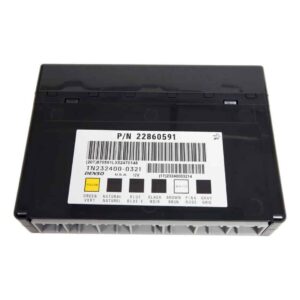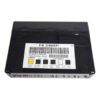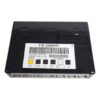Are you chasing electrical gremlins in your 2006-2013 Chevrolet Impala? Intermittent power windows, door locks with a mind of their own, or a security light that won’t turn off are classic signs of a failing Body Control Module (BCM). As the central command center for your vehicle’s body electronics, a faulty BCM can cause a cascade of frustrating and seemingly unrelated problems. Stop the guesswork and endless diagnostics. This is your direct-fit, reliable solution.
This isn’t just a replacement part; it’s a fully prepared restoration of your car’s electronic nervous system. We take the hassle and high cost of dealership repairs out of the equation. Simply provide your vehicle’s VIN at checkout, and our expert technicians will flash this module with the latest, most stable GM software specific to your Impala. It arrives at your door ready to install, saving you a trip to the dealer and hundreds in programming fees.
A Technician’s Notebook: The Haunted Impala
I remember a 2011 Impala that came into the shop with a truly baffling set of symptoms. The customer said his interior lights would flicker randomly, the radio would shut off, and sometimes the car wouldn’t start, showing a ‘Service Theft System’ message. He’d already replaced the battery and alternator. We checked all the grounds and power feeds, which were solid. A scan showed a dozen intermittent U-codes, all pointing to communication loss. After 20 years of seeing this, my gut pointed straight to the BCM. We swapped in a pre-programmed module, and instantly, every single ghost in the machine vanished. It’s a perfect example of how one failing module can make a perfectly good car seem possessed.
Is Your Impala Showing These Symptoms?
- ✔️ Power windows, mirrors, or door locks operating erratically or not at all.
- ✔️ Interior or exterior lights flickering, staying on, or not working.
- ✔️ The anti-theft or security system light is illuminated, preventing the car from starting.
- ✔️ False warnings on the instrument cluster (e.g., ‘Service Airbag,’ ‘Service Traction Control’).
- ✔️ Diagnostic trouble codes (DTCs) related to communication, such as U0140, U0155, or various B-codes.
- ✔️ A/C and heater controls are unresponsive.
A Straightforward Guide to Your BCM Installation
Replacing the 2006-2013 Impala BCM is a job most DIYers can handle with basic tools. For the Impala, the BCM is typically located behind the driver’s side of the dashboard, to the left of the steering column.
- Safety First: Always disconnect the negative terminal from your car’s battery and wait about 10 minutes to allow all systems to power down completely.
- Access the Module: You will likely need to remove the lower dash panel (knee bolster) under the steering wheel to gain access to the BCM. It’s usually held in by a few screws or clips.
- Identify and Unplug: Locate the BCM. It will have several large multi-pin electrical connectors. Carefully press the release tabs on each connector and pull them straight out.
- Swap the BCM: Remove the mounting bolts or clips holding the old BCM in place and take it out. Install your new, pre-programmed module in its place and secure it.
- Reconnect and Test: Firmly plug all electrical connectors back into the new BCM until they click. Reconnect the negative battery terminal. Turn the key to the ‘On’ position (without starting) and test your electronics—windows, locks, lights, etc.
Important Post-Installation Steps
Because this module is pre-programmed, most functions will work immediately. However, depending on your vehicle’s specific configuration, a couple of quick relearn procedures may be needed:
- Airbag System Sync: If the airbag light stays on after installation, a professional scan tool is needed to perform the ‘Setup SDM Primary Key in BCM’ procedure. This syncs the new BCM with the airbag system. This is only required if the light is on.
- Brake Pedal Position Relearn: On some models, a brake pedal position sensor relearn might be necessary for proper brake light and traction control operation.
Verified Vehicle Compatibility
This Body Control Module is a direct replacement for a wide range of GM vehicles. While this listing is focused on the 2006-2013 Impala BCM, it also fits the models listed below. Please verify your part number from the list to ensure perfect compatibility.
Note: Specific options and IDs may apply. Always match your part number.
Cross-Reference Part Numbers:
10382479, 15093910, 15276271, 15299986, 15819552, 15828601, 15837419, 15872388, 15872421, 15880684, 15921352, 15921353, 15948438, 15948439, 20815898, 20839063, 20864767, 20864768, 20921435, 20921436, 20935349, 22860591, 25826124, 25826125, 25847588, 25847589, 25892622, 25910474, 25934762, 25934763, 95151084
Frequently Asked Questions
Why do I need to provide my VIN?
Your VIN (Vehicle Identification Number) allows us to program the BCM with the exact software and settings your Impala had from the factory. This ensures all features work correctly and makes the installation truly plug-and-play, avoiding a costly trip to the dealership.
Is there a core charge?
No, there is no core charge for this module. You can keep your old part, so there’s no need to worry about return shipping or waiting for a refund.
Will this fix my ‘Service Theft System’ light?
Yes, a faulty BCM is one of the most common causes of a persistent ‘Service Theft System’ message and a no-start condition. Because our module is programmed to your VIN, it correctly syncs with your vehicle’s security components, resolving this issue.
What tools do I need for installation?
You’ll typically only need basic hand tools, such as a socket set (likely 7mm and 10mm sockets), a ratchet, and possibly a trim removal tool to safely pry off the dash panel without scratching it. No special electronic tools are required for the physical installation.
What if I still have an issue after installation?
First, double-check that all connectors are fully seated. If an airbag light is on, it may require the ‘SDM Key Setup’ as mentioned above. If other issues persist, it’s possible there’s another underlying problem. However, our VIN-programmed BCM eliminates a major variable, making further diagnosis much simpler.



